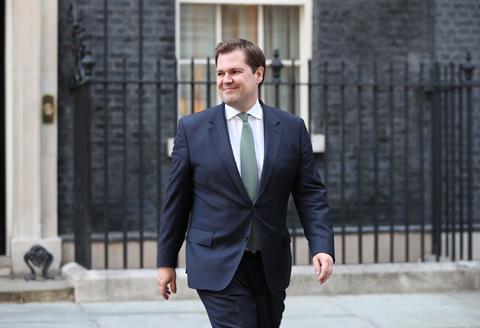Housing secretary says expected ’Accelerated Planning’ document to now take form of white paper
New housing minister Robert Jenrick has re-committed the government to building 300,000 homes a year and suggested the number might even need to be revised upwards.

In a speech outlining major reforms to the planning system he said: “Our 300,000 target by the mid-2020s may not be ambitious enough.
“To do this we have to embrace technology, the technology being brought forward for the digital age to make homes built faster. But we also have to renew our enthusiasm for transforming quality design in the supply of homes so we can build a greener and a better Britain,” he told an event hosted by Policy Exchange and Create Streets yesterday.
Jenrick’s remarks are significant because former housing minister Kit Malthouse cast doubt that the widely cited 300,000 figure was a firm target, commenting in May that the figure was “mythical”.
Jenrick also announced that the long-expected “Accelerated Planning” Green Paper has now been upgraded to a white paper - the step before proposals become official policy or legislation. He gave more detail on how promised “model design codes” announced last month will work, and called on developers and housebuilders to be “ambitious, creative and imaginative” in reusing old buildings.
His comments come after publication of the interim report of the Building Better, Building Beautiful Commission, which argued that bad design was the cause of much opposition to new housing, and recommended that “beauty” be made a core aim of the planning system.
Jenrick praised Wates Residential’s regeneration of the historic buildings at HMS Daedalus near Portsmouth, the first project in Homes England’s new national accelerated delivery programme.
He said this showed it was possible to reconcile two “ostensibly opposing challenges: how we can design beautiful and eye-catching homes while also building at scale, at pace and at low cost”.
“Critics would have us believe that these challenges cannot be solved simultaneously but that cynicism is wrong and unfounded,” he said.
“What we’ve seen in some of the country’s largest and most successful recent developments, from Northstowe in Cambridgeshire to the Stonebridge homes of Yorkshire, to the wonderful redevelopment around King’s Cross is that design which speaks to an area’s heritage, its history and its identity is universally popular.
“In fact, it is only beautiful design, in-keeping with an area’s existing aesthetic and sensitive to local concerns, which unlocks public consent for new development which saves costly delays from legal challenges and frees up developers to get on and the build the homes we need.
“For too long there has been a misconception in the housebuilding industry that quality is the enemy of supply. In fact, experience shows us that it is those developments of the highest quality and the most attractive designs which are approved faster, sell faster and which are the most enduringly popular.
“The exciting technological innovation currently taking place across the sector through modern methods of construction makes it easier than ever before for architects, designers and builders to integrate beauty into their plans without compromising on delivery.”











No comments yet